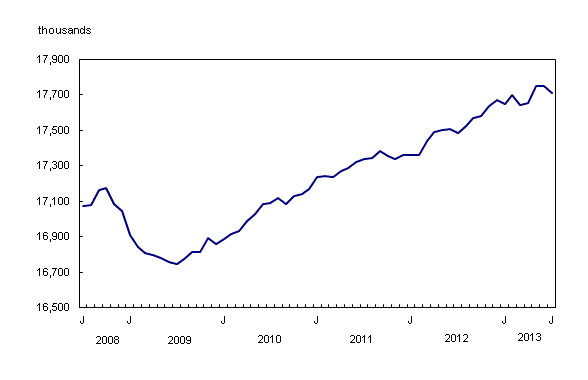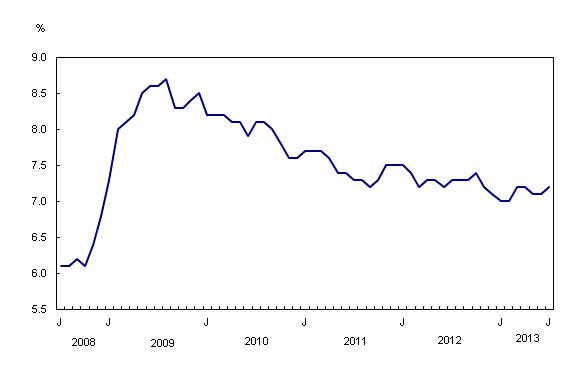Labour Force Survey, July 2013
Archived Content
Information identified as archived is provided for reference, research or recordkeeping purposes. It is not subject to the Government of Canada Web Standards and has not been altered or updated since it was archived. Please "contact us" to request a format other than those available.
Released: 2013-08-09
Led by declines among youths, employment decreased by 39,000 in July, and the unemployment rate rose 0.1 percentage points to 7.2%. With this decrease, employment gains have averaged 11,000 per month over the past six months, slower than the average of 27,000 observed during the preceding six-month period.
Since July 2012, employment has increased 1.3% (+226,000). At the same time, the number of hours worked has grown 0.7%, as part-time employment rose at a faster pace than full time (+2.2% versus +1.1%).
In July, employment declined in Quebec, British Columbia, Nova Scotia, Manitoba as well as in Newfoundland and Labrador. At the same time, there were increases in Alberta, New Brunswick and Saskatchewan.
Employment was down in health care and social assistance, public administration and information, culture and recreation. These declines were partly offset by gains in business, building and other support services.
There were fewer people working in the public sector in July, while there was little change in the number of private sector employees and the self-employed.
Employment declines were concentrated among youths aged 15 to 24, as a result of less hiring this July compared with previous Julys. There were also declines among women aged 55 and over, while there was little change among people aged 25 to 54 and men aged 55 and over.
The employment rate of returning students aged 15 to 24 was similar to that of July 2012. However, fewer students were working full time.
Employment declines in several provinces
In July, the number of workers in Quebec declined by 30,000, pushing the unemployment rate up 0.3 percentage points to 8.2%. On a year-over-year basis, employment grew 1.2%, similar to the national average of 1.3%, with all the growth occurring in the last five months of 2012.
In British Columbia, there were 12,000 fewer people employed in July, and the unemployment rate rose 0.4 percentage points to 6.7%. Compared with 12 months earlier, employment in the province was virtually unchanged.
Following three months of little change, employment in Nova Scotia fell by 4,100 in July. The unemployment rate for the month was unchanged at 9.0%, as fewer people participated in the labour market. On a year-over-year basis, employment was little changed in this province.
Employment in Manitoba was down 3,400 in July, pushing the unemployment rate up 0.5 percentage points to 5.5%. Compared with 12 months earlier, employment in the province grew by 1.5%.
In Newfoundland and Labrador, there were 3,000 fewer people working in July, and the unemployment rate edged up to 11.4%. Compared with 12 months earlier, employment increased by 1.7%. However, employment in this province has been on a downward trend since the start of 2013.
In July, employment in Alberta increased by 17,000, the third notable increase in four months. With this gain, the unemployment rate fell 0.5 percentage points to 4.5%. Year-over-year employment growth was 3.0%, the bulk of which occurred in 2013.
Following a decrease in June, employment rose by 4,000 in New Brunswick in July, and the unemployment rate declined 1.0 percentage point to 10.2%. On a year-over-year basis, employment was little changed.
Employment in Saskatchewan rose for the second consecutive month, up 3,000 in July. Despite this gain, the unemployment rate was up 0.3 percentage points to 4.0%, as more people searched for work. On a year-over-year basis, employment grew by 3.9%, the highest growth rate of all provinces.
In Ontario, employment was little changed in July and the unemployment rate was 7.6%. Compared with 12 months earlier, employment in the province was up 1.2%.
Fewer public sector workers
There were 47,000 fewer people employed in health care and social assistance in July, following steady growth since May 2012. With the decline in July, employment in this industry is back to a level similar to that of 12 months earlier.
In public administration, employment fell 23,000 in July. Compared with July 2012, employment was little changed, as declines in the past five months offset the gains observed earlier in the 12-month period.
Employment in information, culture and recreation decreased for the second consecutive month, down 21,000 in July. As a result, employment in this industry is down 4.2% or 33,000 from 12 months earlier.
Employment rose by 29,000 in business, building and other support services in July. Compared with 12 months earlier, employment grew by 6.2% (+43,000), one of the highest growth rates among all industries.
In July, there were 74,000 fewer people working in the public sector, as a result of declines in health care and social assistance and in public administration. At the same time, there was little change in the number of private sector employees and the self-employed. On a year-over-year basis, public sector employment was little changed, while the number of private sector employees increased 1.5% and the number of self-employed rose 2.4%.
Fewer youths and women aged 55 and over employed
Employment among youths aged 15 to 24 fell by 46,000, as a result of less hiring this July compared with previous Julys. Their unemployment rate was little changed at 13.9%, as fewer youth participated in the labour force. Compared with 12 months earlier, youth employment was little changed.
In July, employment among women aged 55 and over declined by 16,000, the first notable decline since July 2012. For men aged 55 and over, employment was little changed in July. Compared with 12 months earlier, employment for men and women of this age group increased by 155,000 (+4.8%), partly a result of population aging.
Among people aged 25 to 54, employment was little changed in July. Compared with 12 months earlier, employment for this group edged up 0.5% (+57,000), with all the gains in the last five months of 2012.
Student summer employment
From May to August, the Labour Force Survey collects labour market data about young people aged 15 to 24 who were attending school full time in March and who intend to return to school full time in the fall. The published data are not seasonally adjusted; therefore, comparisons can only be made on a year-over-year basis.
Among returning students aged 20 to 24, the employment rate was 69.7% in July, similar to the rate observed in July 2012. Their unemployment rate was 9.1%, little changed from the previous year.
The employment rate for 17- to 19-year-old students was 59.0% in July, similar to the rate observed 12 months earlier. Their unemployment rate, at 16.8%, was little changed compared with July 2012.
The labour market for students aged 15 to 16 remained difficult in July 2013. Their employment rate was 28.6%, the lowest since 1977, when data became available. The unemployment rate for these students was 30.0%, similar to the rate observed 12 months earlier.
For the two younger age groups, the prevalence of part-time work has increased compared with July 2012.
Canada-United States comparison
The unemployment rate in the United States was 7.4% in July, down 0.8 percentage points from 12 months earlier. However, the US rate remains above the Canadian rate of 6.3% (adjusted to US concepts). In Canada, the unemployment rate was unchanged from one year earlier.
In July, the participation rate in the United States was 63.4%, and has declined 2.8 percentage points since 2008. During the same time, the participation rate in Canada (adjusted to US concepts) declined 1.2 percentage points to 66.5%, which is 3.1 percentage points higher than the US rate.
Note to readers
The Labour Force Survey (LFS) estimates are based on a sample and are therefore subject to sampling variability. As a result, monthly estimates will show more variability than trends observed over longer time periods. Estimates for smaller geographic areas or industries also have more variability. For an explanation of sampling variability of estimates and how to use standard errors to assess this variability, consult the "Estimates quality" section of the publication Labour Force Information (Catalogue number71-001-X).
The employment rate is the number of employed persons as a percentage of the population 15 years of age and over. The rate for a particular group (for example, youth aged 15 to 24) is the number employed in that group as a percentage of the population for that group.
The unemployment rate is the number unemployed as a percentage of the labour force (employed and unemployed).
The participation rate is the number of employed and unemployed as a percentage of the population. For more detailed information, see the Guide to the Labour Force Survey (Catalogue number71-543-G).
Unless otherwise stated, this release presents seasonally adjusted estimates, which facilitates comparisons by removing the effects of seasonal variations. For more information on seasonal adjustment, see Seasonal adjustment and identifying economic trends.
Each year, the LFS revises its estimates for the previous three years, using the latest seasonal factors.
A more detailed summary, Labour Force Information (Catalogue number71-001-X), is now available online for the week ending July 20. From the Browse by key resource module of our website under Publications, choose All subjects, then Labour.
Data tables are also now available online. From the Browse by subject module of our website, choose Labour.
The next release of the Labour Force Survey will be on September 6.
Contact information
For more information, contact us (toll-free 1-800-263-1136; infostats@statcan.gc.ca).
To enquire about the concepts, methods or data quality of this release, contact Vincent Ferrao (613-951-4750; vincent.ferrao@statcan.gc.ca) or Jeannine Usalcas (613-951-4720; jeannine.usalcas@statcan.gc.ca), Labour Statistics Division.
- Date modified:



